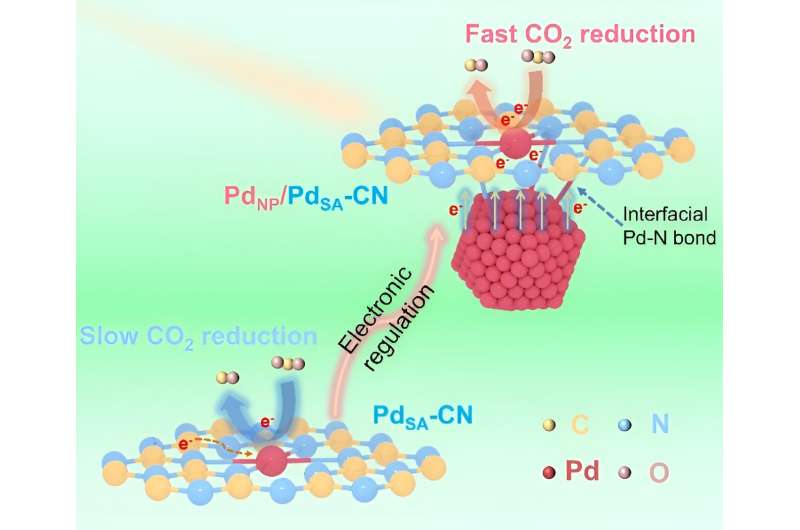This article has been reviewed according to Science X's editorial process and policies. Editors have highlighted the following attributes while ensuring the content's credibility:
fact-checked
proofread
Synergy palladium single atoms and twinned nanoparticles for efficient CO₂ photoreduction

The challenge of regulating the electronic structures of metal single-atoms (M-SAs) with metal nanoparticles (M-NPs) lies in the synthesis of a definite architecture. Such a structure has strong electronic metal-support interactions and maintains electron transport channels to facilitate carbon dioxide photoreduction (CO2PR).
In a study published in Advanced Powder Materials, a group of researchers from Zhejiang Normal University, Zhejiang A&F University and Dalian University of Technology, revealed the engineering of the electron density of Pd single atoms with twinned Pd nanoparticles assisted by strong electronic interaction of the atomic metal with the support and unveiled the underlying mechanism for expedited CO2PR.
"As one of the most promising CO2PR semiconductors, polymeric graphitic carbon nitride (g-C3N4) featured with sp2 π-conjugated lamellar structures can offer electronegative nitrogen atoms to anchor M-SAs, forming active metal-nitrogen moieties (M–Nx)," explained Lei Li, lead author of the study. "However, stable M–Nx configurations forbid tunability of electronic structures of M-SA sites."
In particular, the extent of d-states of transition metals relative to Fermi level dictate metal–adsorbate binding strengths, which should be neither too weak nor too strong for the optimal catalytic activity. Thus, precise tailoring of electronic structures for metal centers is essential for efficient and selective CO2PR.
"Loading M-NPs on the hosts can be applied in modifying the metal single-sites without sacrificing pristine properties. Additionally, considering the high electron density of M-NPs, it is highly probable that charge density rearrangement occurs between M-SAs and M-NPs connected through ligand bridges," added Yong Hu, col-lead and co-corresponding author. "However, electronic interactions of M-SAs with M-NPs synchronously coordinated on g-C3N4 are rarely exploited in photocatalytic applications."
The researchers also found that the electronegative N sites in g-C3N4 bridged Pd-SAs and Pd-TPs, forming Pd–N bonds to create strong electronic metal-support interactions and permitting directional electron transport from Pd-TPs to Pd-SA sites for effective CO2PR.
Both experimental and theoretical studies confirmed the multiple roles of Pd-TPs. The Pd-TPs served as an electron donator to enrich electron density on catalytic centers of single-Pd-sites through N ligands in g-C3N4 networks, thereby down-shifting the d-band center to accelerate carbonyl desorption for CO production.
The team's findings offer a feasible approach to maneuver electronic structures of neighboring metal single sites by integrating metal nanoparticles for photocatalysis.
More information: Lei Li et al, Electron-enriched single-Pd-sites on g-C3N4 nanosheets achieved by in-situ anchoring twinned Pd nanoparticles for efficient CO2 photoreduction, Advanced Powder Materials (2024). DOI: 10.1016/j.apmate.2024.100170
Provided by KeAi Communications Co.




















